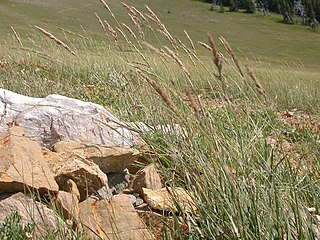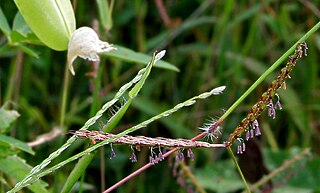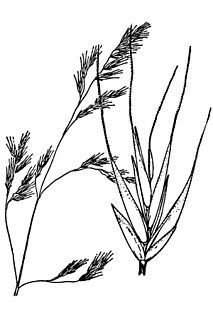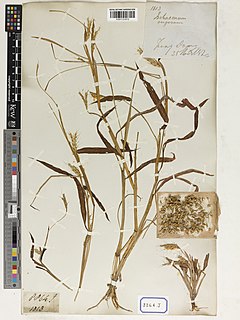
Digitaria is a genus of plants in the grass family native to tropical and warm temperate regions but can occur in tropical, subtropical, and cooler temperate regions as well. Common names include crabgrass, finger-grass, and fonio. They are slender monocotyledonous annual and perennial lawn, pasture, and forage plants; some are often considered lawn pests. Digitus is the Latin word for "finger", and they are distinguished by the long, finger-like inflorescences they produce.

Calamagrostis purpurascens, is a perennial grass commonly known as purple reedgrass, purple pinegrass, or alpine reedgrass. It grows 30 to 80 centimetres (31 in) tall.

Echinochloa crus-galli is a type of wild grass originating from tropical Asia that was formerly classified as a type of panicum grass. It is commonly known as cockspur, barnyard millet, Japanese millet, water grass, common barnyard grass, or simply "barnyard grass". This plant can grow to 60" in height and has long, flat leaves which are often purplish at the base. Most stems are upright, but some will spread out over the ground. Stems are flattened at the base. The seed heads are a distinctive feature, often purplish, with large millet-like seeds in crowded spikelets.

Ischaemum is a taxonomically one of the most formidable genera in a huge tribe Andropogoneae belonging to the grass family, widespread in tropical and semitropical regions in many countries. Many species are known commonly as murainagrass.

Corymbia gummifera, commonly known as red bloodwood, is a species of tree, rarely a mallee, that is endemic to eastern Australia. It has rough, tessellated bark on the trunk and branches, lance-shaped adult leaves, flower buds in groups of seven, creamy white flowers and urn-shaped fruit.

Bromus interruptus, commonly known as the interrupted brome, is a flowering plant in the grass family. It is endemic to southern and central England, which became extinct in the wild in 1972. After several decades in cultivation, the interrupted brome was re-introduced to Aston Rowant National Nature Reserve in 2004, marking the first known re-introduction of an extinct plant in Britain. The plant was a weed of waste places and arable agriculture, particularly of sainfoin cultivation. It can be distinguished from all other Bromus species by its deeply split, or bifid, palea.

Themeda is a genus of plants in the grass family native to Asia, Africa, Australia, and Papuasia. There are about 18 to 26 species, many of which are native to Southeast Asia.

Festuca occidentalis is a species of grass known as western fescue. It is native to much of the northern half of North America and is most widely distributed in the west. It is most often found in forest and woodland habitat. The specific epithet occidentalis is Latin, meaning "western".

Bromus catharticus is a species of brome grass known by the common names rescuegrass, grazing brome, prairie grass, and Schrader's bromegrass. The specific epithet catharticus is Latin, meaning cathartic. The common name rescuegrass refers to the ability of the grass to provide forage after harsh droughts or severe winters. The grass has a diploid number of 42.
Dendrocnide peltata, commonly known simply as the stinging tree or jelaton, is a large tree in the nettle family Urticaceae. With the other species of the genus Dendrocnide, it is known for the stinging hairs which cover the whole plant and cause severe pain when touched. The Latin specific epithet peltata means "shield shaped", referring to the shape of the leaves.
Dendrobium nativitatis, commonly known as the Christmas Island crimp orchid, is a species of epiphytic orchid that is endemic to Christmas Island, an Australian territory in the north-eastern Indian Ocean. It has long, straggly stems, flattened pseudobulbs, a single leathery leaf and a single pale yellow flower.
This is a list of terms and symbols used in scientific names for organisms, and in describing the names. For proper parts of the names themselves, see List of Latin and Greek words commonly used in systematic names. Note that many of the abbreviations are used with or without a stop.

Digitaria insularis is a species of grass commonly known as sourgrass. It is native to Central and South America and the southern parts of the United States and has been introduced into other parts of the world. It was first described by the German botanist Friedrich Karl Georg Fedde in 1904.

Aristida rufescens is a grass species native to Madagascar and to Mayotte in the Comoros archipelago. It was described by German agrostologist Ernst Gottlieb von Steudel in 1854.

Bromus japonicus, the Japanese brome, is an annual brome grass native to Eurasia. The grass has a diploid number of 14.

Bromus rigidus, the ripgut brome, is a grass native to Eurasia and naturalized in North America. The specific epithet rigidus means rigid or stiff.

Ischaemum rugosum, also known as saramollagrass, is a flowering plant belonging to the grass family Poaceae in the genus Ischaemum, and is native to tropical and temperate regions of Asia, growing in marshes and other wet habitats. It is a vigorous annual, and is an invasive species in South America and Madagascar. It reaches heights of up to 1 m and is primarily recognized by the ridged surface of its sessile spikelet’s lower glume. Despite its historic importance as fodder in Asia, the grass has become a major weed in mid-latitude rice paddies throughout Asia and South America.













